Install the app
How to install the app on iOS
Follow along with the video below to see how to install our site as a web app on your home screen.
Note: This feature may not be available in some browsers.
You are using an out of date browser. It may not display this or other websites correctly.
You should upgrade or use an alternative browser.
You should upgrade or use an alternative browser.
Bullet seating measurement...CBTO or shoulder datum point to ogive?
- Thread starter PatMiles
- Start date
dellet
Gold $$ Contributor
Ultimately the only one that matters is shoulder to lands, those are your contact points, that’s what determines jump or jam.
To put it in a silly perspective, if CTBO is a .020” jam, I could set the shoulder at the .200” line and the only effect would be reduced case capacity. So by itself is a pointless measurement unless it’s a rimmed case.
No matter how you do it, you need both measurements, but you generally set base to shoulder datum, headspace, only once, and tune shoulder to lands or seated depth.
The third measurement needed would be base to ogive of the bullet.
How you get there is simply a choice.
To put it in a silly perspective, if CTBO is a .020” jam, I could set the shoulder at the .200” line and the only effect would be reduced case capacity. So by itself is a pointless measurement unless it’s a rimmed case.
No matter how you do it, you need both measurements, but you generally set base to shoulder datum, headspace, only once, and tune shoulder to lands or seated depth.
The third measurement needed would be base to ogive of the bullet.
How you get there is simply a choice.
Last edited:
I may be totally ignorant, usually am, but if you have your cases sized properly from a headspace perspective, aren't they two sides of the same bridge?
I think it is a matter of accumulating tolerances. Any variation in CBTO shows up as a variable in seating depth after the firing pin strike forces the case forward to seat on the shoulder. I looked for a way to eliminate this variable and finally came to a very simple solution. I glued a washer into the base of my Wilson die that makes the die float on the case with its shoulder in contact with the top of the die. In a perfect world this wouldn't be necessary but with the annealing and case spring back issues it helps. If you are loading .050 of the lands maybe not so much. If you are in the lands it should help. I seat with a K&M arbor press with a forcepack that prevents me from resizing the case in the seating die 



I agree there is a POSSIBLIITY of tollerence stack up, BUT THAT IS WHY DETAILS MATTER.
I MEASURE ogive to base, my bullets are uniform and sorted, my case sorted and prepped, my powder uniform in weight, as is my neck tension.
your personal accuracy requirements will determine how much effort you put into your ammo.
I MEASURE ogive to base, my bullets are uniform and sorted, my case sorted and prepped, my powder uniform in weight, as is my neck tension.
your personal accuracy requirements will determine how much effort you put into your ammo.
Dusty Stevens
Shiner
If your seater die contacts the bullet at a different point than you measure it from then youre at the mercy of your bullet mfr
Now that the train is rollin, let's wreck it!!If your seater die contacts the bullet at a different point than you measure it from then youre at the mercy of your bullet mfr
Following a well know LR BR shooter I've started sorting OAL of projectile and not BBTO.
Reason being the seater stem contact is closer to the tip than ogive.
I'm noticing a tighter CBTO ".001-.0015" variation in doing this than just working with comparitor measurements alone.
Measuring BBTO I was noticing as much as .004 in variation.
Comparitor measurements are still necessary to get data and confirm desired seating depths.
How'd I do, did I run it completely off the tracks?
Dusty Stevens
Shiner
Not yetNow that the train is rollin, let's wreck it!!
Following a well know LR BR shooter I've started sorting OAL of projectile and not BBTO.
Reason being the seater stem contact is closer to the tip than ogive.
I'm noticing a tighter CBTO ".001-.0015" variation in doing this than just working with comparitor measurements alone.
Measuring BBTO I was noticing as much as .004 in variation.
Comparitor measurements are still necessary to get data and confirm desired seating depths.
How'd I do, did I run it completely off the tracks?
If your seater die contacts the bullet at a different point than you measure it from then youre at the mercy of your bullet mfr
This is why, as I've mention in previous threads, I short my bullets with a comparator insert having the same diameter/contact-point as my seating stem. While there'll be some variance in CBTO, that doesn't bother me since I don't seat to touch or jam and I get very consistent seating depth (where the relationship of the base of the case to the base of the bullet is consistent for a case volume as consistent as possible below the bullet).
Now that the train is rollin, let's wreck it!!
Following a well know LR BR shooter I've started sorting OAL of projectile and not BBTO.
Reason being the seater stem contact is closer to the tip than ogive.
I'm noticing a tighter CBTO ".001-.0015" variation in doing this than just working with comparitor measurements alone.
Measuring BBTO I was noticing as much as .004 in variation.
Comparitor measurements are still necessary to get data and confirm desired seating depths.
How'd I do, did I run it completely off the tracks?
You need something like George McDonalds SO/CO tool that measures both the typical ogive and also where the seater stem contacts the bullet.
rwj
Gold $$ Contributor
If what’s desired is a consistent amount of jump or jam regardless of bullet nose variation, wouldn’t one need a gauge/seater stem having the same profile as the rifling lands? That could initially be accomplished in a new barrel using the chamber reamer. But accounting for erosion would quickly become a challenge!
Ned Ludd
Silver $$ Contributor
As long as the prepped cases have a very consistent cartridge base-to-shoulder (CBTS) measurement and you consistently bump the shoulder back .001" to .002", it really doesn't matter. In my hands, CBTS is typically one of the most consistent measurements I take during the reloading process. One complaint regarding the Hornady OAL gauge is that the brass isn't necessarily dimensionally identical to fired brass from a given chamber. Again, it doesn't really matter. If you take a CBTO measurement with the bullet just barely touching the lands using the OAL gauge (or any other method), you will use that as your reference/starting point in order to set up a seating depth test.
From that point on, you can actually measure the CBTO of all loaded rounds with very good accuracy, to at least +/- .001". Because you will actually be shooting those loaded round in a seating depth test, the target itself will tell you what the optimal CBTO or seating depth measurement is. At that point, issues such as slight differences between the brass case in the OAL gauge and brass fired in a given rifle effectively disappear. The initial measurement is only a reference value, nothing more.
From that point on, you can actually measure the CBTO of all loaded rounds with very good accuracy, to at least +/- .001". Because you will actually be shooting those loaded round in a seating depth test, the target itself will tell you what the optimal CBTO or seating depth measurement is. At that point, issues such as slight differences between the brass case in the OAL gauge and brass fired in a given rifle effectively disappear. The initial measurement is only a reference value, nothing more.
Chaotik
Gold $$ Contributor
Oh boy... another tool!View attachment 1306696Don’t overlook this gage
. . . seems I can never have enough. Like having the10 different pliers in my tool drawer.Oh boy... another tool!
D-4297
Gold $$ Contributor
As Ned has said ; It's a reference , or starting point . It allows testing for load value , and then allows for adjusting the seating depth from that referential starting point . I found that the closer I have my cases Bumped , to minimize headspace variations , the easier it is to bring everything else in line . Since I anneal after every firing , Bumping .001 isn't a crisis . Good case prep makes for consistent ammo .As long as the prepped cases have a very consistent cartridge base-to-shoulder (CBTS) measurement and you consistently bump the shoulder back .001" to .002", it really doesn't matter. In my hands, CBTS is typically one of the most consistent measurements I take during the reloading process. One complaint regarding the Hornady OAL gauge is that the brass isn't necessarily dimensionally identical to fired brass from a given chamber. Again, it doesn't really matter. If you take a CBTO measurement with the bullet just barely touching the lands using the OAL gauge (or any other method), you will use that as your reference/starting point in order to set up a seating depth test.
From that point on, you can actually measure the CBTO of all loaded rounds with very good accuracy, to at least +/- .001". Because you will actually be shooting those loaded round in a seating depth test, the target itself will tell you what the optimal CBTO or seating depth measurement is. At that point, issues such as slight differences between the brass case in the OAL gauge and brass fired in a given rifle effectively disappear. The initial measurement is only a reference value, nothing more.
Similar threads
- Replies
- 22
- Views
- 2,402
Upgrades & Donations
This Forum's expenses are primarily paid by member contributions. You can upgrade your Forum membership in seconds. Gold and Silver members get unlimited FREE classifieds for one year. Gold members can upload custom avatars.

Click Upgrade Membership Button ABOVE to get Gold or Silver Status.
You can also donate any amount, large or small, with the button below. Include your Forum Name in the PayPal Notes field.
To DONATE by CHECK, or make a recurring donation, CLICK HERE to learn how.

Click Upgrade Membership Button ABOVE to get Gold or Silver Status.
You can also donate any amount, large or small, with the button below. Include your Forum Name in the PayPal Notes field.
To DONATE by CHECK, or make a recurring donation, CLICK HERE to learn how.









